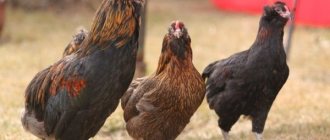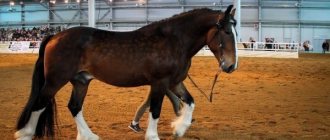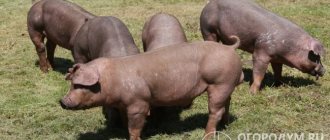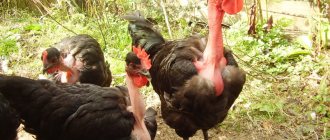Peculiarities
They stand out among other species with their lush plumage. Brama is a source of high-quality white meat and high-quality large eggs.
These huge birds are absolutely unpretentious to the conditions in which they will be raised. They are not afraid of the cold, they are not afraid of dampness and are not picky about their diet. In winter, unlike other species, on the contrary, they begin to lay eggs better.
Thanks to these qualities, the breed is becoming more and more in demand and goes deeper into Russia, reaching the northern regions. But it is worth highlighting that Brahma has subspecies, which we will describe below.
Light
These are large chickens with shaggy strong legs. The light Brahma's color is predominantly white, and the mane and tail are painted black. A defect in the breed is the presence of a yellow tint and a white tail.
The breed was bred as a meat breed. She feels great in harsh living conditions.
On average, one young laying hen produces about 120 eggs per year. The eggs are large, weighing up to 60 grams. The shell is strong, dark brown in color.
A decrease in egg production occurs in the 3rd year of a bird’s life. Five-year-old individuals produce no more than 60 eggs per year.
Dark
This type of chicken is characterized by a difference in the color of the rooster and hen. Females have gray plumage, with gray head feathers with occasional black spots.
The roosters, in turn, are painted in black and white. The mane is white, with a grayish tint.
In terms of productive characteristics, this variety is identical to the light Brahma.
Fawn
In size and type of color it is similar to the previous one. Females have a different plumage color than males. The chicken has a soft brown color with a slight yellowish tint. Roosters' mane and tail have a deeper, reddish color, with black stripes. The tail is black.
Partridge
It is not difficult to guess that the breed received this name solely because of its color. But it only applies to females. After all, a rooster, unlike a chicken, has a brighter color.
Speaking about eggs, I would like to note the characteristic dark dots that are present on the shell.
This subspecies is slightly lighter than light and dark Brahma. Productivity is about 110 eggs per year.
Productivity
The productivity indicators of different subtypes of brahma are almost the same. Adult chickens weigh approximately 3.5-4 kg on the scale, roosters weigh 1 kg more.
Laying hens mature quite late - they begin laying eggs no earlier than at 8-9 months . However, they can lay eggs up to 4-5 years of age, without paying much attention to weather and climatic conditions, including winter cold. The average chicken produces about 100-120 eggs per year, the weight of each of which usually does not exceed 60 g. The eggshell is quite hard and has a brown or cream color.
Despite its large size and large mass, the breed is much inferior to cross-breed chickens for meat production due to its slow growth rate. The meat is rough and fibrous, but has good taste.
Many farmers consider it profitable to keep only young individuals. In chickens, after reaching 2 years of age, egg production decreases, and roosters older than 3 years begin to lose sexual activity, which leads to a decrease in egg fertilization.
An experienced poultry farmer talks about how profitable it is to breed this breed in the following video:
Content
If you are planning to raise chickens of this breed, then keep in mind that a small house will not work for them. Brahma are very large birds. The ideal perch height should be at least forty centimeters in height and at least 30 centimeters in width.
Also, it is worth noting that it is necessary to provide light to Brahma for at least 14 hours. In view of this, experienced farmers use lighting in the chicken coop in winter.
Brama are not afraid of frost and they easily survive the winter in a cold chicken coop. However, to improve the living conditions of the birds, dry sawdust is used as bedding.
To prevent chickens from suffering from parasites, provide the birds with access to ash and sand. It is especially important to do this in winter. In summer, also, a container with these components is placed on the site for bathing the birds.
As for the walking area, there are no special requirements. The breed is not particularly playful, so it gets along well even in a limited area.
It is possible to grow without a rooster. At the same time, the bird does not begin to lay eggs worse. But, nevertheless, if there is a rooster with the chickens, they will feel more confident.
Origin story
Brahma are birds of Asian origin, bred on the basis of Cochins and Asian breeds of chickens. The grown population continued to be bred “inside”, and in the 19th century, a breed standard was described and approved in the USA. After this, laying hens and roosters in “trousers” began to be sold officially.
The characteristics of Brahma chickens were highly appreciated by poultry farmers all over the world, because initially the luxurious birds were so heavy that they could barely stand on their feet. The live weight of the rooster reached 7 kg, and this is comparable to the indicators of the best modern meat crosses.
Soon productivity began to decline, as they began to breed mainly individuals with outstanding decorative qualities - lush feather cover on the body and legs.
Advantages and disadvantages of the breed
Despite the fact that this is a fairly old breed, it still competes on equal terms with most modern, more promising crosses. And all this thanks to a number of advantages, among which it is worth noting:
- Beautiful, decorative appearance.
- High adaptability to harsh climate conditions.
- Good meat with excellent taste.
- Easy to care for.
- Calm, friendly character.
- Great maternal instinct.
Are there any disadvantages? If we talk about any serious ones, then there are none. However, many farmers do not like the fact that chickens of this breed take a very long time to mature.
Where can I buy in Russia?
Thanks to its meat qualities, unpretentiousness and endurance, as well as its calm disposition and good egg production, Partridge Brahma ranks second among the chicken breeds bred in Russia.
Many farms offer customers their products: poultry meat, eggs, chickens, young animals and even breeding stock. Below is a short overview of Russian farms that breed Partridge Brahma.
- Nursery of purebred poultry " Kurkurovo ": Moscow region, Lukhovitsky district, Kurovo village, no. 33. Telephone. Internet site: www.kurkurovo.ru
- Poultry farm " Orlovsky Dvorik ": Moscow region, Mytishchi, Pogranichny deadlock street, no. 4. Phone: +7 (915) 009-20-08. Internet site: www.orlovdvor.ru
- : Orenburg region, Saraktash district, Izyak-Nikitino village. Phone: +7 (353) 220-46-33. Website: orenptitsa.ru
Breeding chickens
Laying hens of this breed are very specific and some difficulties may arise during breeding of new offspring:
- Due to the fact that Brahma chickens are quite large, they can accidentally crush eggs during incubation.
- Also, sometimes chickens turn off their maternal instinct, and they abandon nests with eggs for a long period of time.
- Chickens take a very long time to grow. This is a big disadvantage, since young animals bred at the end of summer may simply not have time to get stronger before the onset of frost.
Otherwise, raising chickens does not cause any difficulties. The survival rate among young animals reaches almost 100%.
In order for young animals to develop normally and gain muscle mass, they need to be provided with a good, balanced diet.
At the same time, it is worth paying attention to the fact that Brahma are prone to gaining excess weight, which will negatively affect not only the quality of the meat, but also the productivity of the chicken.
Underfeeding is also dangerous, since then the already slowly growing breed is further inhibited in its development.
In order for chickens to grow faster, high-protein grain mixtures must be added to their diet. It is also very important to include the following supplements in your diet:
- Fish meal.
- Boiled eggs.
- Cottage cheese.
What diseases are purebred chicken susceptible to?
One of the most common diseases is coccidiosis. The infection is inherited from parental individuals, and can also be acquired through soil and insects. Also, Brahma and Orpington breeds are susceptible to joint diseases due to weakness of the limbs with heavy weight. Poor nutrition can cause vitamin deficiency.
In one season, Brama chickens can have from two to five diseases, and it is very important to carry out prevention on time, and in the case of an already advanced process, intensive and correct treatment.
In rare cases, birds are exposed to pasteurellosis, respiratory diseases, and hypothermia. Blockage of the digestive organs and, in particular, goiter is also likely. In order to prevent the occurrence of characteristic diseases, including infectious ones, it is necessary to carry out preventive measures. Thus, feeding containers must be thoroughly cleaned before each serving of food, and also systematically treated with disinfectants. Against parasites, special baths made from a mixture of tar and vegetable oil should be used. You can learn about the symptoms and treatment of coccidiosis in this material. Vaccination is also a preventative measure. As a rule, drugs against bird flu are used for Brahma chickens. To prevent the development of rickets, fish oil is added to the food of chickens.
The presence of vitamins in the diet (especially vitamin D), calcium and other minerals is extremely important for the prevention of deficiency pathologies, as well as bone and joint diseases. A strong skeleton is necessary to maintain body weight.
Feeding
Feeding absolutely any breed of chicken should be thoughtful and of high quality.
The bird must receive the proper amount of minerals, vitamins, etc. They need sand and gravel. It improves the functioning of the gastrointestinal tract. Usually, they are poured into a separate container and placed next to the main food.
Feed the bird 3 times a day. Usually they adhere to a standard scheme like: grain mixtures-porridge-grain.
Don't forget about water. Birds must have access to clean water. Its temperature should be as close to room temperature as possible. Pour water into clean containers, which are washed regularly.
Chickens often scoop up food from the feeder. To prevent such “pampering”, special feeders with high sides are made. Their height should not be higher than the level of the chicken's chest.
conclusions
- Shaggy-legged chickens of the Brahma breed (Cochin, Blue Partridge, Isabella, Wyandot Orpington purebred) have two important properties: large body weight (they can weigh a lot) and pleasant color and appearance.
- The bird is not afraid of the cold, so it can be kept in relatively cold regions without additional heating.
- Poultry meat has excellent taste and is directly dependent on feeding.
- The cost of adult birds (how long they can stand) and young birds is relatively high, so you can also make a profit from sales.
Diseases
Brahma has a fairly strong immune system, but this does not mean that the chicken does not need to be taken care of. In order to prevent a number of diseases, farmers recommend:
- Disinfect the premises once every 6 months. It will clear the chicken coop of ticks, fleas and other pests that can cause serious damage to the chickens.
- To prevent chickens from being infested by parasites, you need to install containers with wood ash in the chicken coop and in the yard, where the chickens can periodically “bathe”.
- In order to protect chickens from colds, chickens are vaccinated against bird flu at the age of several days.
- To improve immunity, chickens are given a weak solution of potassium permanganate or water with antibiotics diluted in it.
- To prevent a disease such as rickets, which often occurs in heavy breeds, chickens are given fish oil or fish waste at least once a week.
- The room in which the bird lives should be dry and well ventilated, but without drafts. To protect the room from dampness, a bedding made of suitable materials is laid on the floor: hay, straw, peat, sand, sawdust, etc.
What do Brahms get sick of?
Chickens of this breed may suffer from diseases characteristic of domestic birds. Today we will talk about some of them
Inflammation and prolapse of the oviduct
This disease may result from stimulation of egg production in laying hens that are not physiologically ready for this. Chickens are given a lot of protein food and daylight hours are increased. If the egg is large or irregular in shape (with lime deposits), problems with the oviduct are possible. This occurs especially often in pullets due to digestive disorders.
To prevent prolapse, as well as inflammation of the oviduct, it is necessary to ensure the impeccable cleanliness of the chicken coop, an abundance of green feed, and a balanced composition of vitamins and minerals. It is equally important to take a responsible approach to activities that stimulate egg laying in young females.
Egg retention in the oviduct
This happens in large birds due to:
- violations of oviduct peristalsis;
- promoting large eggs;
- scared.
The bird needs help, so you need to:
- Apply dry heat to bottom of chicken for 20 to 30 minutes;
- Treat the cloaca with Vaseline.
- Place the hen in a separate cage.
The egg will come out within 2-2.5 hours. If not, you will have to lubricate the cloaca again and try to push the egg out with a light massage. When it is large, you should crush it and carefully take it out in parts. If this is not done, the bird will die.
Blockage and inflammation of the goiter
Similar problems often arise after:
- eating sour feed;
- dry diet;
- long fasting.
To save the chicken, the cervicothoracic area is massaged in the projection of the goiter. For this:
- the bird is held by the legs, head down;
- stroke the neck towards the beak.
As soon as the crop is freed, the hen will feel better. After the procedure, Brahma is soldered with a weak solution of manganese, and at the next meal he is given a fermented milk product, for example, yogurt.
Frostbite
Brams are resistant to cold, but at minus 10°C, in an uninsulated chicken coop, they can freeze combs, earrings, legs and the outer part of the cloaca.
In this case, the affected areas are wiped with alcohol and then treated with Vaseline. The bird is transferred to an insulated barn, or the heater is turned on.
Heatstroke
This can happen if it's hot outside. Chickens do not have sweat glands, so they maintain thermoregulation by breathing quickly and with an open beak. When a bird lives in a cramped and stuffy chicken coop in the summer, the danger of heat stroke is even greater.
To reduce the likelihood of death, it is necessary to reduce crowding in the barn, and build a canopy in the yard so that the birds can hide in the shade. The borderline temperature is considered to be 35°C and above.
Partridge variety
The name of the subbreed speaks for itself. Brahma partridge chickens have plumage similar to the color of a partridge. They are characterized by the outline of a feather on a field background.
Representatives of the subspecies lay special eggs. They have more pronounced inclusions.
Males are brightly colored. There is a bright red feather on the neck, back, and head, but in other places it is black.
The partridge breed Brahma weighs on average 3.5 kg of hens, and roosters - about 4 kilograms. In a year, the bird is capable of laying about 110 eggs weighing 50 grams.
Price
It is recommended to purchase hatching eggs, chicks, adult hens and roosters from experienced breeders. Their cost varies depending on the gender and age of the individual.
Approximate prices:
- eggs – 40-80 rubles/piece;
- chickens (up to 2 months) – 150-300 rubles/piece;
- adult roosters and hens – 450-750 rubles/piece.
Compared to roosters, laying hens are more expensive. Before buying, you need to carefully examine the bird: nondescript plumage, dilated pupils, stuck together feathers in the tail area may indicate the development of the disease. Brahma chickens, as a separate breed, are popular among farmers. The photo may not always match the description. A slight defect in the plumage will not affect the taste of the meat. Usually the cost of such individuals is much lower.
Price
Purebred birds can be purchased at specialized breeding farms or from private breeders. Brahmas are considered common hens, so finding young or hatching eggs is not difficult.
Before purchasing, you need to check all the necessary certificates to avoid an outbreak on your farm. The average price for eggs for incubation is 150 rubles, reared young animals cost a little more - from 300 rubles. Breeding roosters with quality characteristics of the breed are the most expensive; their price tag starts from 1000 rubles.
Bird temperament
Brahma chickens (photos and descriptions are presented in the article for informational purposes) are quite calm in nature. They do not show aggression towards representatives of other breeds, preferring to remain neutral. According to reviews, a small area is enough for females and males of Brahma to live comfortably. Representatives of this breed are hardy and unpretentious. Chickens and roosters do not show fussiness and do not enter into open conflicts with ducks, geese and other birds.
They are resistant to low temperatures and can adapt to any weather conditions.











